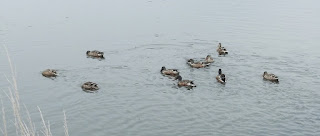NATURE
MONCTON INFORMATION LINE, 21 November 2020 (Saturday)
To respond by email, please address your
message to the information line editor, nelsonpoirier435@gmail.com
Please advise the editor at
nelsonpoirier435@gmail.com if any errors are noted in wording or photo
labelling.
For more information on Nature Moncton, check
the website at www.naturemoncton.com
Edited by: Nelson Poirier nelsonpoirier435@gmail.com
Transcript by: Catherine Clements
Info Line #: 506-384-6397 (384-NEWS)
**Peter
Gadd in Miramichi comments it is hard to get a sense of just how many NORTERN
CARDINALS there are in northeast NB at the moment. There seem to be many
reports. Deana has seen that there are many reports (via eBird) along the Gaspé
coast and the north shore of the St Lawrence even as far as Havre St. Pierre,
north of Anticosti Island. On Friday, the Gadd's had 6 Northern Cardinals at their
feeder yard, 3 male and 3 female! We often get Northern Cardinals show up
at this time of year but not in the numbers we are seeing this year. Are we
being to optimistic to call it a fallout!
The RED-BELLIED
WOODPECKER that dropped in on the Gadds feeder yard sporadically earlier is now
a regular. When a Red-bellied Woodpecker chooses a winter feeder yard, it can
become very faithful. It is enjoying black oil sunflower seeds as well as
peanuts and it seems to be stashing seeds in nearby tree bark. They have been
fortunate to have PINE GROSBEAKS this week as well. There was a flock of 70 COMMON
REDPOLLS at Miramichi Marsh enjoying Grey Birch catkins on Friday as well as a MERLIN
which surprisingly paid little attention to the flock of redpolls.
The
winter bird feeding season continues to look better and better!
**Clarence Cormier reports that he had a flock
of 15 PINE GROSBEAKS [Durbec des sapins] along his lane on Thursday in
Grande-Digue, as well as a flock of 20 EVENING GROSBEAKS [Gros-bec errant]. He
has 10 BLUE JAYS [Geai bleu], which he finds higher than other years, but a
portion of Blue Jays do migrate, so that may reduce soon.
**Brian
Stone tried again on Friday to get photos of the female EURASIAN WIGEON [Canard
siffleur] that Richard Blacquiere found at the Hampton lagoon. It continued to
be present but forecasted sun did not show for good photos.
As always,
Brian noted other things. A MUSKRAT [Rat musqué] did a swim-by. He got some
closer photos of the seemingly untouched COMMON BARBERRY [Épine-vinette]
berries. We have two barberry species in New Brunswick: Common and JAPANESE
[Épine-vinette du Japon]. The Common Barberry is the intermediate host of WHEAT
RUST FUNGUS [Rouille jaune], so it is problematic around wheat-growing areas.
Common Barberry has a serrated leaf edge, while Japanese has an entire leaf,
and Common Barberry also has a three-barbed spine. There is a lot of barberry
on Route 114 in Albert County, but I’m not sure of the species. Brian also
photographed a RED-BELTED POLYPORE MUSHROOM [Polypore pinicole]. The outer edge
is not red yet, as it is new growth. BALD EAGLES [Pygargue à tête blanche] were
keeping an eye over the area. Brian also photographed groups of SHOVELER ducks
[Canard souchet] showing plumage that suggests the males are still moving out
of eclipse plumage and/or these are immature males. I noted the same scenario
at Arthur Street lagoon in Memramcook last week.
Nelson Poirier,
Nature Moncton


















































